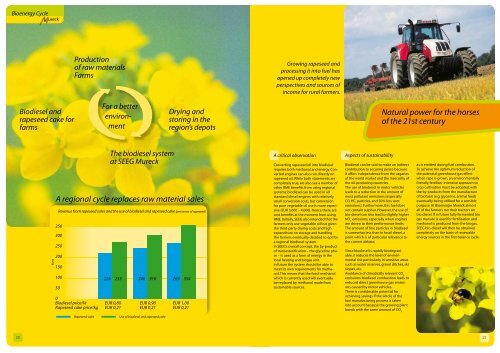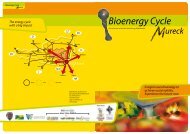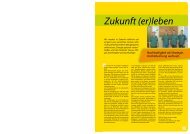Pages 3 to 21 - Seeg
Pages 3 to 21 - Seeg
Pages 3 to 21 - Seeg
You also want an ePaper? Increase the reach of your titles
YUMPU automatically turns print PDFs into web optimized ePapers that Google loves.
Bioenergy Cycle ureck<br />
20<br />
Biodiesel and<br />
rapeseed cake for<br />
farms<br />
Euro<br />
Production<br />
of raw materials<br />
Farms<br />
For a better<br />
environment<br />
The biodiesel system<br />
at SEEG Mureck<br />
Drying and<br />
s<strong>to</strong>ring in the<br />
region’s depots<br />
A regional cycle replaces raw material sales<br />
Revenue from rapeseed sales and the use of biodiesel and rapeseed cake (per <strong>to</strong>nne of rapeseed)<br />
350<br />
300<br />
250<br />
200<br />
150<br />
100<br />
50<br />
224 233 246 316 269 354<br />
0<br />
Biodiesel price/lit EUR 0,80 EUR 0,90 EUR 1,00<br />
Rapeseed cake price/kg EUR 0,<strong>21</strong> EUR 0,<strong>21</strong> EUR 0,<strong>21</strong><br />
Rapeseed sales Use of biodiesel and rapeseed cake<br />
Growing rapeseed and<br />
processing it in<strong>to</strong> fuel has<br />
opened up completely new<br />
perspectives and sources of<br />
income for rural farmers.<br />
A critical observation<br />
Converting rapeseed oil in<strong>to</strong> biodiesel<br />
requires both methanol and energy. Converted<br />
engines can also run directly on<br />
rapeseed oil. While both statements are<br />
completely true, we also see a number of<br />
other RME benefits from using regional<br />
systems: biodiesel can be used in all<br />
standard diesel engines with relatively<br />
small conversion costs, but conversion<br />
for pure vegetable oil use is more expensive<br />
(EUR 3,000 – 4,000). Hence there are<br />
cost benefits at the moment from using<br />
RME. Initially, SEEG also intended that the<br />
farmers only use vegetable oil but given<br />
the third-party drying costs and high<br />
expenditure on s<strong>to</strong>rage and handling<br />
the farmers eventually decided <strong>to</strong> opt for<br />
a regional biodiesel system.<br />
In SEEG’s overall concept, the by-product<br />
of transesterification – the glycerine phase<br />
– is used as a form of energy in the<br />
local heating and biogas unit.<br />
In future the system should be able <strong>to</strong><br />
meet its own requirements for methanol.<br />
This means that the fossil methanol<br />
which is currently used will eventually<br />
be replaced by methanol made from<br />
sustainable sources.<br />
Aspects of sustainability<br />
Biodiesel can be said <strong>to</strong> make an indirect<br />
contribution <strong>to</strong> securing peace because<br />
it offers independence from the vagaries<br />
of the world market and the insecurity of<br />
the oil-producing countries.<br />
The use of biodiesel in mo<strong>to</strong>r vehicles<br />
leads <strong>to</strong> a reduction in the amount of<br />
most pollutant emissions (especially<br />
CO, HC, particles, and 50% less soot<br />
emissions). Furthermore, this fuel does<br />
not contain sulphur. However, the use of<br />
bio-diesel can also lead <strong>to</strong> slightly higher<br />
NO X emissions, especially when engines<br />
are driven <strong>to</strong> their performance limits.<br />
The amount of fine particles in biodiesel<br />
is somewhat less than in fossil diesel, a<br />
point which is of particular relevance <strong>to</strong><br />
the current debate.<br />
Since biodiesel is rapidly biodegradable,<br />
it reduces the level of environmental<br />
risk particularly in sensitive areas<br />
such as water reserves, gravel ditches, ski<br />
slopes, etc.<br />
Avoidance of climatically relevant CO 2<br />
emissions: biodiesel combustion leads <strong>to</strong><br />
reduced direct greenhouse gas emissions<br />
caused by mo<strong>to</strong>r vehicles.<br />
There is considerable potential for<br />
achieving savings if the whole of the<br />
fuel manufacturing process is taken<br />
in<strong>to</strong> account because the growing plant<br />
bonds with the same amount of CO 2<br />
Natural power for the horses<br />
of the <strong>21</strong>st century<br />
as is emitted during fuel combustion.<br />
To achieve the optimum reduction of<br />
the potential greenhouse gas effect<br />
when rape is grown, an environmentally<br />
friendly, fertiliser-intensive approach <strong>to</strong><br />
crop cultivation must be adopted, with<br />
the by-products from the manufacture<br />
of biofuels (e.g. glycerine, animal feed)<br />
eventually being utilised for a sensible<br />
purpose. At Bioenergie Mureck almost<br />
all of the farmers run their trac<strong>to</strong>rs on<br />
bio diesel. If in future fully fermented bio<br />
gas manure is used for fertilisation and<br />
methanol is produced from the biogas,<br />
SEEG bio-diesel will then be obtained<br />
completely on the basis of renewable<br />
energy sources in the first balance cycle.<br />
<strong>21</strong>









